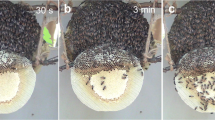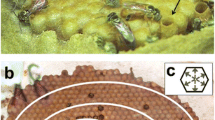Summary
Division of labour was studied in a colony ofM. favosa with individually age-marked workers. The average longevity of these workers was 40 days. Construction and provisioning of brood cells, and operculation of provisioned cells, is performed most by bees aged 8–12 days. Worker ovipositions occur between 9–27 days of age, while workers of 15–16 days are most active in this respect. Waste-processing at the rubbish dump ic carried out by bees of nearly all ages. Guarding is performed by bees aged 19–48 days. From the study of egg-laying behaviour of individual workers, and from the occurrence of ovary development in fixed age-marked bees, we inferred that all workers were once layers. About 50% of the workers may lay one egg and the other 50% may lay two eggs. The laying of three eggs by one worker was observed once. The successive eggs of a single worker may be laid at varying intervals, ranging from 0–8 days. Laying workers are not the main provisioners of the cell in which they lay. Regularly they do not even discharge larval food in this cell at all, since they generally lay their eggs at the end of the period of several days in which they are active dischargers.
The evolution of egg-laying by workers is discussed. In this respect reference is also made to our recent finding of an as yet unknown form of queen dominance in bees. This pertains to her control of the quality of the worker-laid eggs. The comparison between the ontogenetic division of labour in stingless bees and honeybees reveals distinct disparities with respect to the temporal organization of nest activities and the general occurrence of queenright worker oviposition.
Resume
Dans l'une des colonies deM. favosa, on a étudié la division du travail chez les ouvrières, toutes individuellement marquées en fonction de leur âge. La longévité moyenne de ces ouvrières est de 40 jours. Les ouvrières du même âge réalisent plusieurs tâches en rapport avec la reproduction. Les abeilles de 8 à 12 jours s'occupent l plupart du temps de la construction et de l'approvisionnement des cellules à couvain. Les ouvrières pondent du 9e au 27e jour, avec un maximum aux 15e et 16e jours. Presque toutes les abeilles participent au traitement des ordures et des excréments. Les abeilles de 19 à 48 jours montent la garde. A partir des études faites sur le comportement de chaque ouvrière pendant la ponte et de l'existence d'un développement ovarien chez les abeilles à des âges fixés, nous pouvons conclure que toutes les ouvrières ont été pondeuses. A peu près 50% des ouvrières ne pondent qu'un seul œuf tandis que les autres en pondent deux. On a observé une fois une ouvrière pondant trois œufs. Une seule ouvrière peut pondre ses œufs successifs à des intervalles allant de o à 8 jours. Les ouvrières-pondeuses ne sont pas les approvisionneuses les plus actives de la cellule où elles pondent. Régulièrement elles ne se déchargent même pas dans cette cellule, puisqu'en général elles pondent au terme de la période de plusieurs jours où elles se déchargent activement.
L'évolution de la ponte des ouvrières a donné lieu à beaucoup de discussions. A ce propos nous signalons notre découverte récente d'un aspect, jusqu'à présent inconnu, de la dominance de la reine chez les abeilles. Cet aspect concerne le contrôle de la qualité des œufs pondus par les ouvrières. La comparaison entre la division ontogénétique du travail chez les abeilles sans dard et l'abeille domestique,Apis mellifera, fait relever des variations distinctes dans l'organisation temporelle des activités dans le nid et l'apparition générale d'ouvrières-pondeuses en présence de la reine près de la cellule.
Similar content being viewed by others
References
Bassindale R., 1955. — The biology of the stingless beeTrigona (Hypotrigona) gribodoi Magretti.Proc. Zool. Soc. London,125, 49–62.
Bego L., Simoes D., 1972. — Relação entre estrutura etária (normal e anormal) de colonias deScaptotrigona postica Latreille e desenvolvimento glandular (Hymenoptera: Apidae). In:Homenagen à Warwick E. Kerr, 135–142, 1972.
Beig D., 1972. — The production of males in queenright colonies ofTrigona (Scaptotrigona) postica.J. Apicult. Res., 11, 33–39.
Brian M.V., 1979. — Caste differentiation and division of labor. In:Social Insects I, ed. H.R. Hermann, 121–222, 1979, Academic Press, New York.
Butler C., 1609. —The feminine monarchie. On a treatise concerning bees, and the due ordering of them. Joseph Bornes, Oxford.
Calabi P., Traniello J.F.A., Werner M.H. — Age polyethism: its occurrence in the antpheidole hortensis, and some general considerations.Psyche (in press).
Ceccato S., 1970. — Divisao de trabalho entre as operârias deMelipona rufiventris flavolineata Friese (Hymn., Apoidæ).Dissertaçao de Mestrado, Departamento de Zoologia, Instituto de Biociências (U.S.P.), São Paulo.
Darchen R., 1970. — La division du travail chez quelques apides sociaux, abeilles domestiques et méliponides.Gaz. Apicult., 750, 48–51.
Darchen R., 1969. — Sur la biologie deTrigona (Apotrigona) nebulata comiensis. L. I.Biologia gabonica, 5, 151–187.
Free J.B., 1965. — The allocation of duties among worker honeybees.Symp. Zool. Soc. Lond., 14, 39–59.
Hebling N.J., Kerr W.E., Kerr F.S., 1964. — Divisão de trabalho entre operárias deTrigona (Sca.) xanthotricha Moure.Pap. Avuls. Depto. Zool., Secret. Agr., São Paulo, 16, 115–127.
Kerr W.E., Santos Neto G.R. dos, 1956. — Contribuição para o conhecimento da bionomia dos Meliponini V: Divisao de trabalho entre operárias deM. quadrifasciata quadrifasciata Lep.Ins. Soc., 3, 423–430.
Lindauer M., 1952. — Ein Beitrag zur Frage der Arbeitsteilung im Bienenstaat.Z. Vergl. Physiol., 34, 299–345.
Michener C.D., 1974. —The social behaviour of the bees. Harvard Univ. Press, Cambridge, Mass.
Michener C.D., 1963. — Division of labor among primitively social bees.Science, 141, 434–435.
Oster G.F., Wilson E.O., 1978. —Caste and ecology in the social insects. Princeton University Press, Princeton, New Jersey.
Sakagami S.F., 1982. — Stingless bees. In:Social Insects III, ed. H.R. Hermann, 361–423. 1982, Academic Press, New York.
Sakagami S.F., Beig D., Zucchi R., Akahira Y., 1963. — Occurrence of ovary-developed workers in queenright colonies of stingless bees.Rev. Brasil. Biol., 23, 115–129.
Seeley T.D., 1982. — Adaptive significance of the age polyethism schedule in honeybee colonies.Behav. Ecol. Sociobiol., 11, 287–293.
Sekiguchi K., Sakagami S.F., 1966. — Structure of foraging population and related problems in the honeybee, with considerations on the division of labour in bee colonies.Hokkaido National Agricultural Experiment Station, Report no. 69.
Sommeijer M.F., Beuvens F.T., Verbeek H.J., 1982. — Distribution of labour among workers ofMelipona favosa: construction and provisioning of brood cells.Ins. Soc., 29, 222–237.
Sommeijer M.J., Rooy G.A., de,Punt W., Bruijn L.L.M. de, 1983. — A comparative study of foraging behavior and pollen resources of various stingless bees (Hym., Meliponinae) and honeybees (Hym., Apinae) in Trinidad, West-Indies.Apidologie, 14, 205–224.
Sommeijer M.J., Velthuis H.H.W., 1977 — Worker oviposition in orphan colonies ofMelipona favosa F.Proc. Int. Congr. I.U.S.S.I., Wageningen, 315–316.
Sommeijer M.J., Zeijl M. van,Dohmen M.R., 1984. — Morphological differences between worker-laid eggs from a quenright colony and a queenless colony ofMelipona rufiventris paraensis (Hymenoptera: Apidae).Entomol. Berichten, 44, 91–95.
Simões D., Bego L.R., 1979. — Estudo de regulação social emNannotrigona (Scaptotrigona) postica Latreille, em duas colônie (normal e com rainhas virgens), com especial referência ao polietismo etário (Hym., Apidae, Meliponinae).Bolm. Zool. Univ. S. Paulo, 4, 89–98.
Terada Y., Garofalo C.A., Sakagami S.F., 1975. — Age-survival curves for workers of two eusocial bees (A. mellifera andPlebeia droryana) in a subtropical climate, with notes on worker polyethism inP. droryana.J. Apic. Res., 14, 161–170.
Wilson E.O., 1980a. — Caste and division of labor in leaf-cutter ants (Hym.: Formicidae:Atta). I: The overall pattern inA. sexdans.Behav. Ecol. Sociobiol., 7, 143–156.
Wilson E.O., 1980b. — Caste and division of labor in leaf-cutter ants (Hym.: Formicidæ:Atta). II: The ergonomic optimization of leaf cutting.Behav. Ecol. Sociobiol., 7, 157–165.
Wilson E.O., 1976. — Behavioral descretization and the number of castes in an ant species.Behav. Ecol. Sociobiol., 1 141–154.
Wilson E.O., 1975. —Sociobiology: the new synthesis. Harvard Univ. Press, Cambridge, Mass.
Wilson E.O., 1971. —The insect societies. Harvard Univ. Press, Cambridge, Mass.
Author information
Authors and Affiliations
Rights and permissions
About this article
Cite this article
Sommeijer, M.J. Distribution of labour among workers ofMelipona favosa F.: Age-polyethism and worker oviposition. Ins. Soc 31, 171–184 (1984). https://doi.org/10.1007/BF02232713
Received:
Accepted:
Issue Date:
DOI: https://doi.org/10.1007/BF02232713




